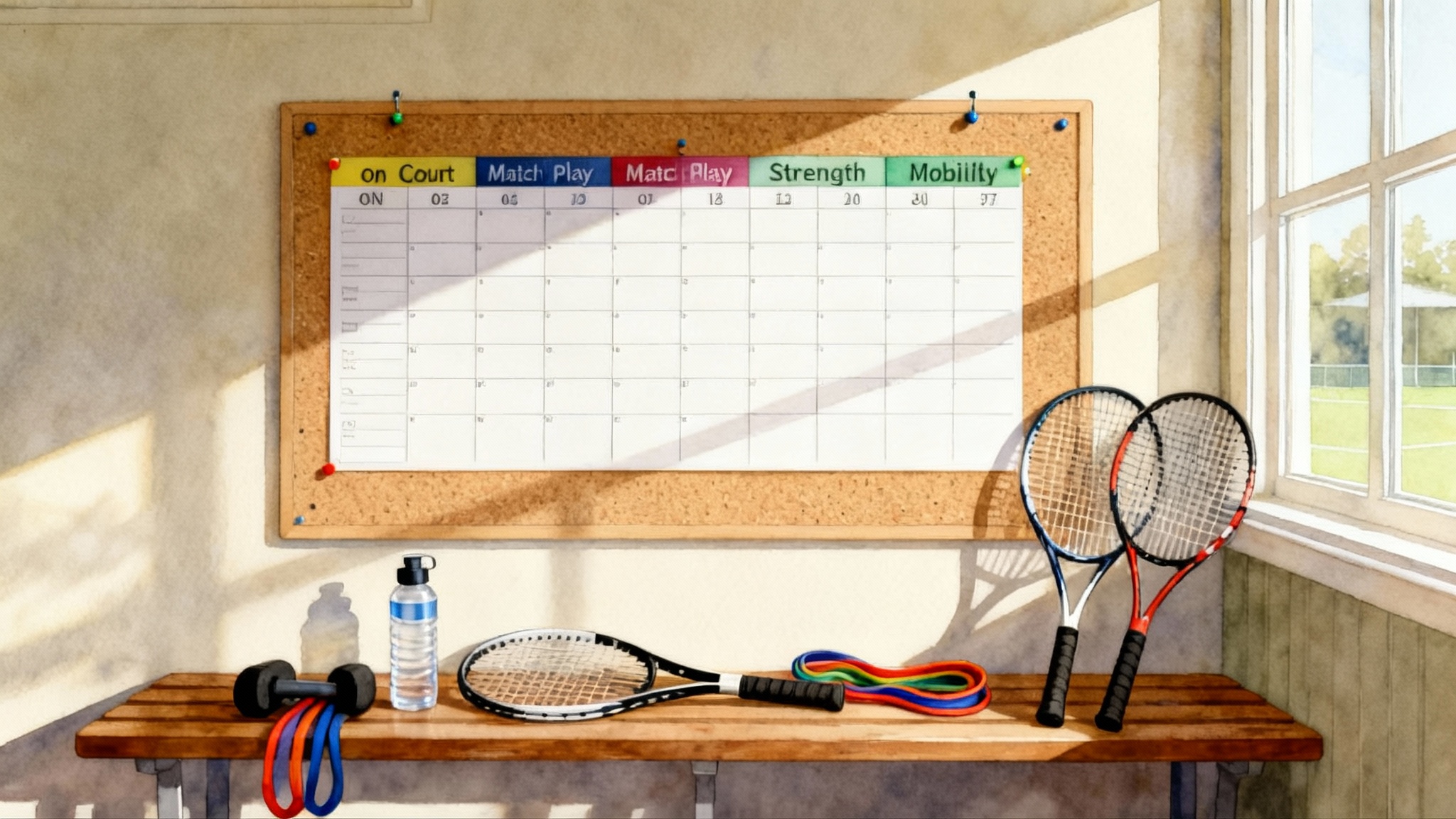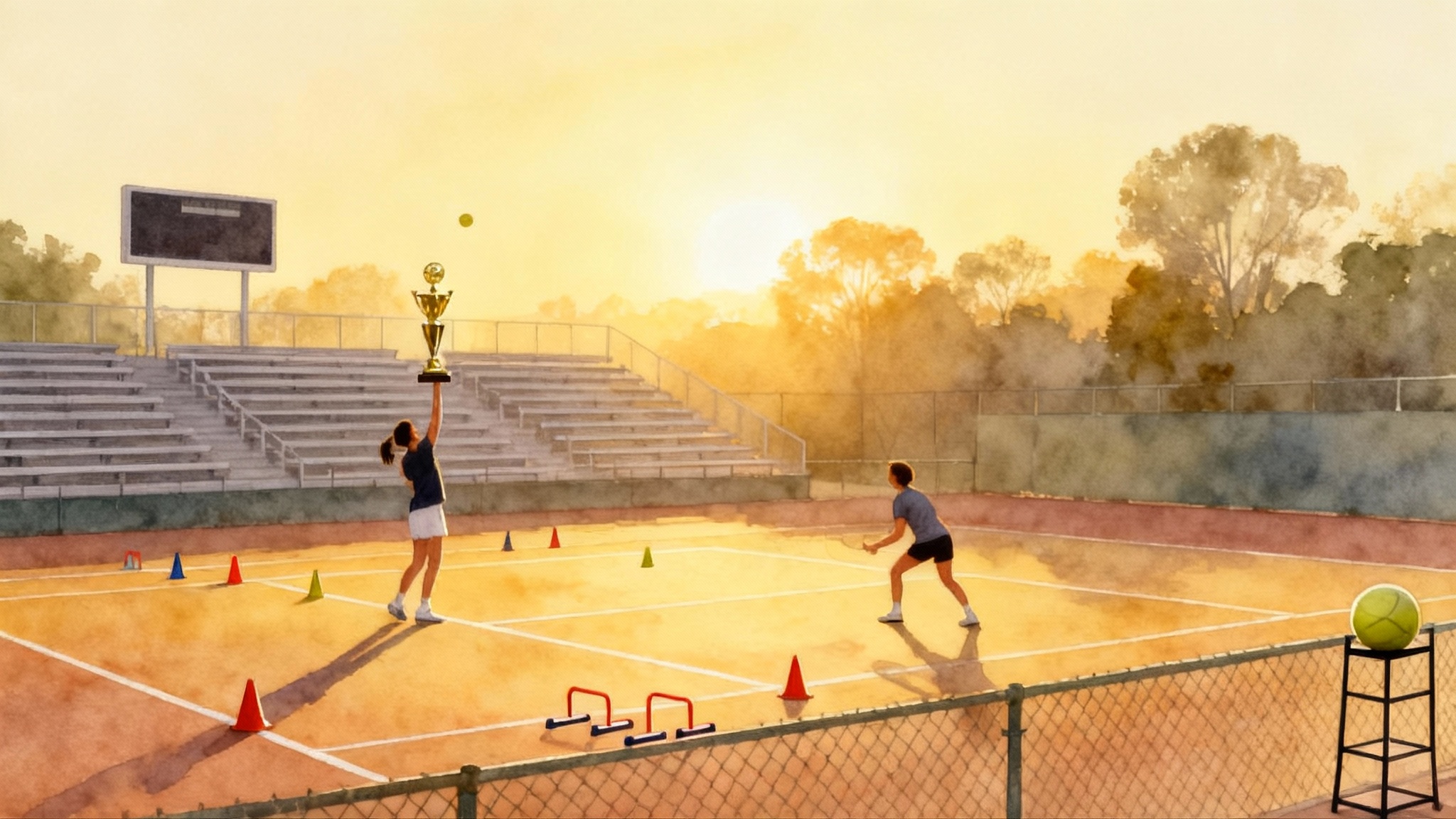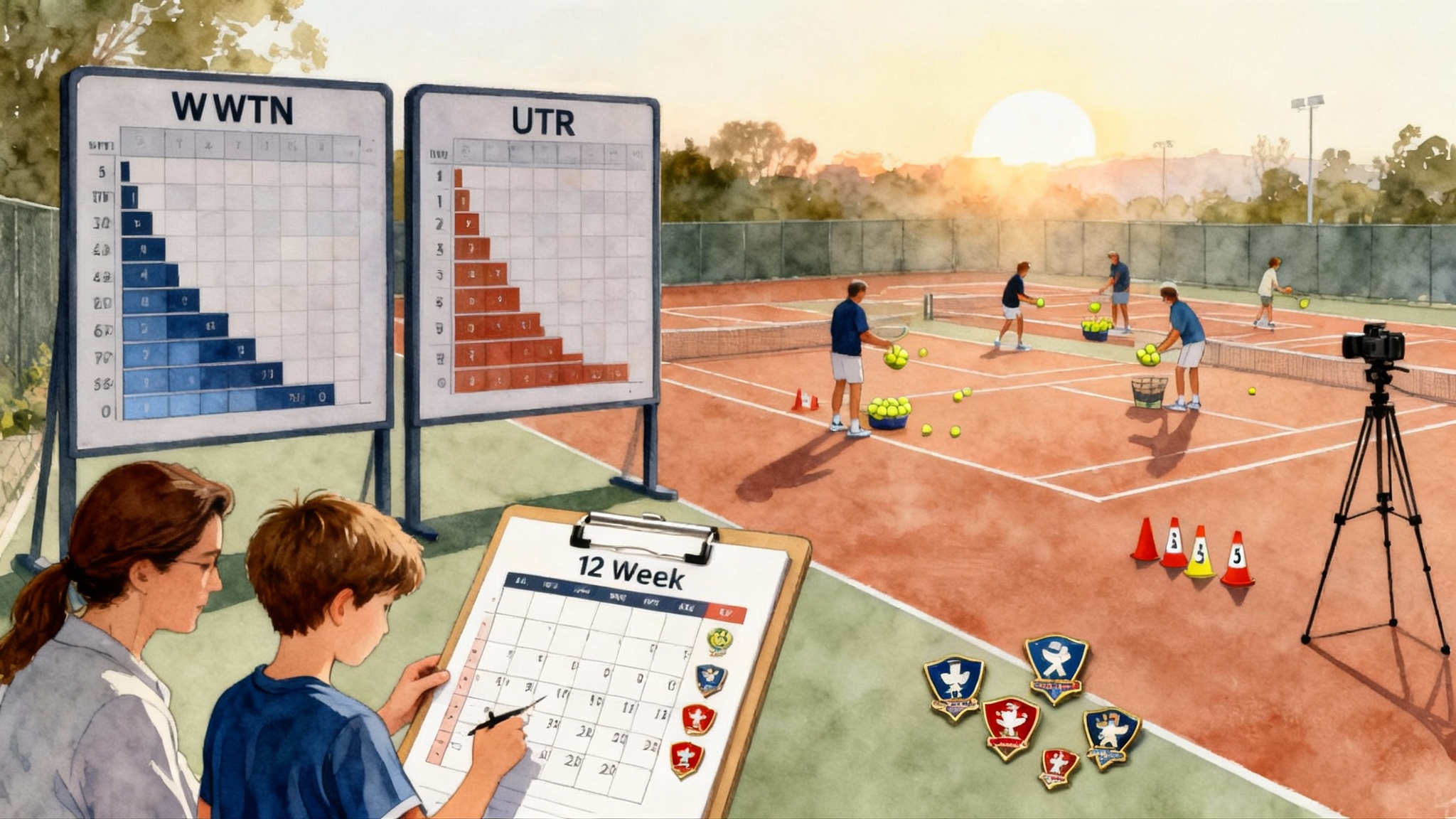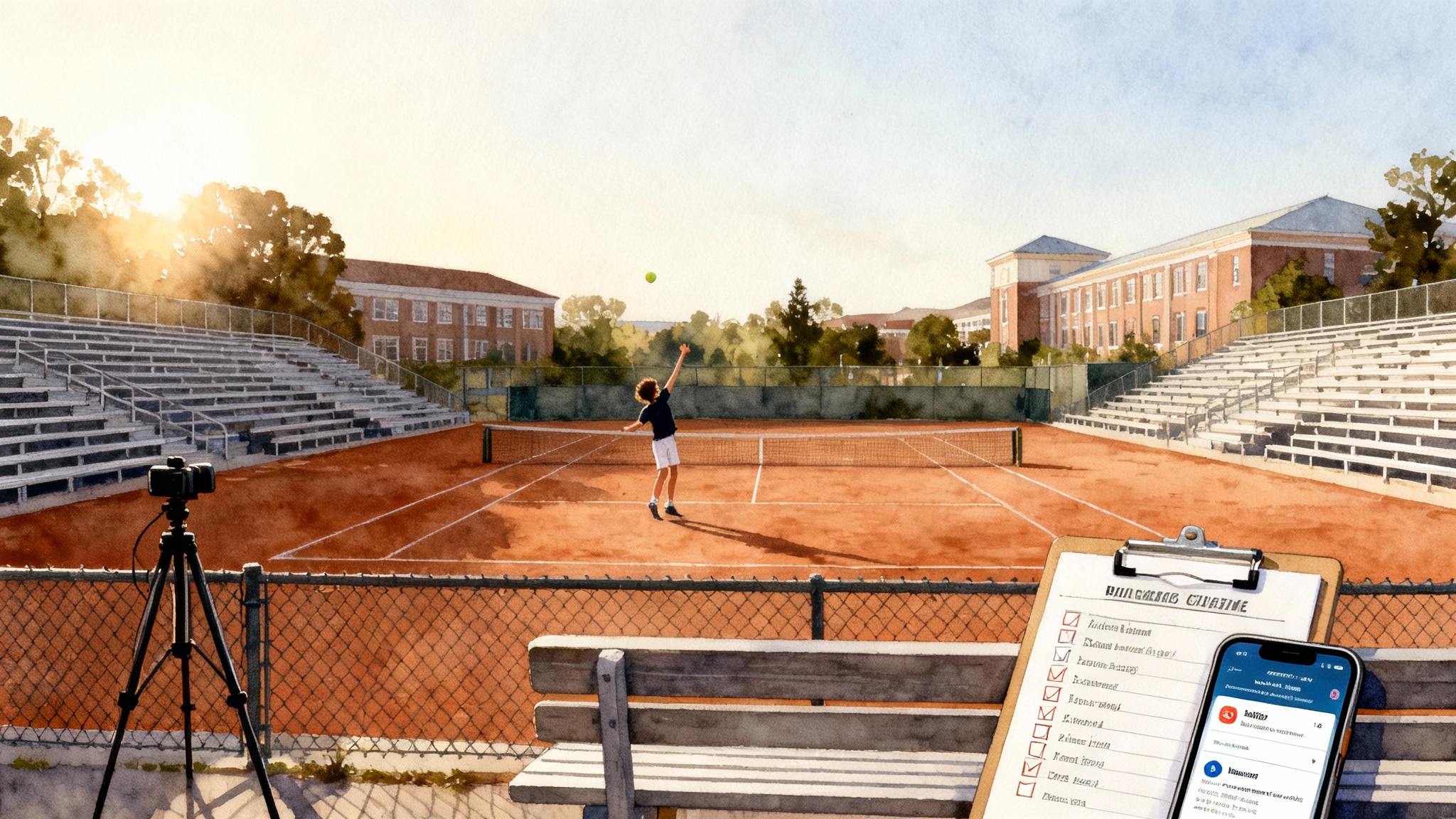How Many Hours to Train in 2025: Weekly Tennis Plans by Age
A practical, research-backed guide to weekly tennis volume in 2025. See age-by-age targets across on-court work, strength, mobility, and match play, with school-year and summer schedules, red flags, checkpoints, and low-resource options.

Why weekly volume is the most important decision you will make this year
In tennis, consistency beats intensity. What you do every week shapes your body, your brain, and your ranking more than any single camp or hero session. A good weekly plan clarifies how many total hours to train, how to divide those hours across on-court practice, match play, strength, and mobility, and how to scale when school ends or tournament load spikes.
Think of your week as a four-slice pie:
- On-court training: technical and tactical drills, live ball, serve and return reps
- Match play: practice sets, league matches, or tournaments
- Strength and conditioning: strength, speed, conditioning, and prehab
- Mobility and recovery: mobility circuits, stretching, soft tissue, sleep hygiene
Your goal in 2025 is to size the pie to your age and level, then keep the slices in balance. For juniors, a simple safety rule helps set the ceiling: organized sport hours per week should be age appropriate. Many medical and performance bodies summarize this as a limit of hours per week not exceeding age. Use that as an upper bound, not as a target. If you are 12, you do not need 12 hours. You need the right hours.
Below you will find age-by-age ranges that include on-court work, strength, mobility, and match play. These are practical, not theoretical. They are built to survive school demands, travel, and real life.
How to count your hours fairly
- Count organized on-court practices, private lessons, fitness sessions, and match play.
- Do not count school physical education class or recess toward your organized sport hours. Keep a note of them, since they contribute to overall fatigue.
- Travel days to tournaments count as a light training day if you also hit or lift. If it is only travel, record it as rest.
- Sleep is the multiplier. Protect eight to ten hours for teens, nine to twelve for children, and seven to nine for competitive adults. If your sleep drops, reduce volume that week.
Age-by-age weekly plans for 2025
Ranges below reflect total organized sport hours. If you are coming off a break, add time gradually by ten to fifteen percent per week until you reach your range.
Ages 6–8 Red and Orange Ball
- Total weekly hours: 3–5
- Suggested split: on-court 2–3, match play 0.5, strength and movement skills 0.5, mobility 0.5
- Focus: fun, basic coordination, tracking the ball, simple athletic patterns such as skipping, hopping, and shuffling
- Progression checkpoint every 6 weeks: can rally 8 balls with coach feed, can shadow split step and first step on cue, can land soft on jumps
School-year sample week
- Mon: 45 minutes on-court skills, 15 minutes movement games
- Wed: 60 minutes red or orange ball group
- Sat: 30 minutes friendly points, 15 minutes mobility, 15 minutes hop and skip circuit
Summer sample week
- Mon: 60 minutes group
- Thu: 45 minutes group, 15 minutes movement games
- Sat: 45 minutes family rally and serves, 15 minutes mobility
Low-resource tips: chalk ladder on the driveway, balloon or foam ball rallies in the living room, small backpack filled with books for light resistance carries under supervision.
Ages 9–10 Orange and Green Ball
- Total weekly hours: 4–7
- Suggested split: on-court 3–4, match play 1, strength and speed 0.5–1, mobility 0.5
- Focus: stable contact, serve rhythm, recovery steps, fun competition
- Checkpoint every 8 weeks: serve toss repeats to a box 10 times, two patterns of play that the athlete can explain in words, can land single-leg soft on both sides
School-year sample week
- Mon: 75 minutes squad practice
- Wed: 60 minutes private or semi-private; 15 minutes mobility
- Fri: 30 minutes speed games, 30 minutes serves and returns
- Sun: 60 minutes practice sets or team match
Summer sample week
- Mon: 90 minutes squad
- Tue: 30 minutes speed and coordination, 15 minutes mobility
- Thu: 90 minutes squad
- Sat: 60 minutes practice sets
Low-resource tips: resistance bands for pulls and squats; timed shuttle runs on a quiet sidewalk; plastic cones or water bottles to mark recovery steps.
Ages 11–12 Green to Yellow Ball
- Total weekly hours: 6–9
- Suggested split: on-court 4–5, match play 1–2, strength 1, mobility 0.5–1
- Focus: serve patterns, first strike plus plus-one, speed of split step, two strength days touching push, pull, hinge, squat with bodyweight
- Checkpoint every 8–10 weeks: accurate serve to two targets per side, maintain 20-ball rally with depth targets, add five percent to flying ten-meter sprint speed without losing form
School-year sample week
- Mon: 90 minutes squad, 15 minutes mobility
- Wed: 60 minutes gym basics, 15 minutes prehab
- Fri: 60 minutes technical private, 15 minutes serves
- Sat or Sun: 90 minutes match play
Summer sample week
- Mon: 120 minutes squad with fitness blocks inside
- Wed: 60 minutes gym, 15 minutes mobility; 45 minutes evening serves
- Fri: 90 minutes live ball and points
- Sat: tournament or two practice sets
Low-resource tips: milk-jug carries, slow eccentric push-ups, partner band rows, seated wall sits for time, jump rope, and a five-move mobility routine.
Ages 13–14 Yellow Ball, growth spurts begin
- Total weekly hours: 8–12
- Suggested split: on-court 5–7, match play 1–2, strength 1.5–2, mobility 0.5–1
- Focus: technique holds through growth, simple periodization, two gym days that progress load slowly, sprint mechanics and deceleration skills
- Checkpoint every 10 weeks: second serve holds up under pressure games, win rate in practice sets is improving, squat pattern stays stable to parallel depth without knee valgus
School-year sample week
- Mon: 90 minutes squad with pattern work; 15 minutes mobility
- Tue: 60 minutes strength and sprint mechanics
- Thu: 90 minutes squad with point construction; 15 minutes serves
- Sat: two practice sets or tournament day
Summer sample week
- Mon: 120 minutes squad plus 20 minutes speed
- Tue: 60 minutes strength, 15 minutes mobility
- Thu: 120 minutes squad with live ball
- Sat: tournament matches or three practice sets spread across morning and evening
Low-resource tips: two buckets filled with sand for deadlift and carry patterns, hill sprints at a park, stair bounds with careful landing.
Ages 15–16 Varsity pathway or sectional tournaments
- Total weekly hours: 10–14
- Suggested split: on-court 6–8, match play 2, strength 2–3, mobility 0.5–1
- Focus: clear game identity, physical robustness, fitness that matches style, weekly video review of a set or two
- Checkpoint every 12 weeks: first serve percentage above 60 in match logs, ability to play three sets on consecutive days without drop in movement quality, two-rep strength standards that improve modestly without soreness hangover
School-year sample week
- Mon: 90 minutes squad with serve plus first ball; 15 minutes mobility
- Tue: 75 minutes strength and conditioning
- Thu: 90 minutes squad with point play; 15 minutes serves
- Fri: 45 minutes speed and footwork, 15 minutes prehab
- Sat or Sun: tournament or two practice sets
Summer sample week
- Mon: 120 minutes squad plus 20 minutes speed
- Tue: 75 minutes strength, 15 minutes mobility
- Thu: 120 minutes squad with live ball and situational games
- Sat: tournament day; Sun: recovery mobility and short serves only if needed
Low-resource tips: backpack split squats, towel isometrics for pulling, tempo push-ups, timed plank series, and five by ten meter accelerations on grass.
Ages 17–18 College pathway or national tournaments
- Total weekly hours: 10–16
- Suggested split: on-court 7–9, match play 2–3, strength 2–3, mobility 1
- Focus: tournament rhythm, travel resilience, heat adaptation in summer, power before speed before volume
- Checkpoint every 12–16 weeks: match charting reveals a winning pattern that shows up under stress, serve plus one conversion rates are rising, clean testing week without tendon pain at the patellar or elbow common extensor sites
School-year sample week
- Mon: 120 minutes on-court with heavy serve and return; 20 minutes mobility
- Tue: 75 minutes strength and power
- Thu: 120 minutes point play and patterns; 15 minutes serves
- Fri: 45 minutes speed and conditioning finishers
- Sat or Sun: tournament or three sets spread across the day
Summer sample week
- Mon: 120 minutes squad plus 20 minutes speed
- Tue: 75 minutes strength, 15 minutes mobility
- Wed: 60 minutes technical tune-up
- Fri: 120 minutes live ball and points
- Sat and Sun: tournament
Competitive adults
You may balance work, travel, and family. The key is honest accounting. Adults recover more slowly after hard matches than they remember.
- Club competitors, 3.0–4.0 level: 5–7 hours per week. On-court 3–4, match play 1–2, strength 1, mobility 0.5
- Tournament-minded adults, 4.5 and above: 7–10 hours per week. On-court 4–5, match play 2–3, strength 1–2, mobility 0.5–1
Two sample adult weeks
- Work-heavy week: Tue 60 minutes hitting; Thu 45 minutes strength; Sat 90 minutes doubles; Sun 60 minutes singles plus 15 minutes mobility
- Pre-tournament week: Mon 75 minutes drilling; Wed 45 minutes strength and speed; Fri 45 minutes serves and returns; Sat and Sun matches
An academy-style template you can copy at home
Austin Tennis Academy popularized a simple integrated model: after-school squads, short fitness blocks wrapped into practice, repeatable strength templates, regular match play, and parent-friendly schedules. Here is a template inspired by that approach that you can run at a club, public park, or school.
Core principles
- Two squad practices per week that always start with five minutes of prehab and end with five minutes of mobility
- Two short fitness blocks per week tied to the squad sessions
- One additional technical or serve session of 30 to 45 minutes
- One match play window on the weekend
- One full rest day and one light day
Plug-and-play week
- Monday: 90 minutes squad that includes 10 minutes of speed and 10 minutes of strength; finish with five minutes mobility
- Wednesday: 90 minutes squad that includes 10 minutes of strength and 10 minutes of conditioning; finish with five minutes mobility
- Friday: 30 to 45 minutes technical tune-up focused on serve or one pattern of play
- Saturday: match play, two sets or a tournament block
- Daily: five to ten minutes of mobility at home
If you have access to a full gym, progress loads slowly and prioritize movement quality over weight. If you do not, use bands, a jump rope, a sturdy backpack for loaded carries, and hills for sprinting. For a deeper offseason layout, see our 2025 preseason strength plan.
School-year versus summer: how to scale without breaking
During the school year, most juniors can tolerate four training days and one match window. In summer, many jump to five or six. The trap is a sudden volume spike.
Use this simple ramp:
- If you plan to add a day in summer, reduce each session slightly for the first two weeks, then build time back in.
- Keep weekly increases to roughly ten percent until you reach your new steady range.
- Protect at least one full day off per week and a lighter day before tournaments.
Two practical calendars
School-year baseline, ages 13–16
- Mon: 90 minutes squad plus 15 minutes mobility
- Tue: 60 to 75 minutes strength and speed
- Thu: 90 minutes squad plus 15 minutes serves
- Sat: two practice sets or tournament day
- Sun: rest
Summer baseline, ages 13–16
- Mon: 120 minutes squad with built-in fitness
- Tue: 60 to 75 minutes strength and speed
- Thu: 120 minutes live ball and points
- Sat: tournament or two to three practice sets
- Sun: mobility only, nervous system rest
Red flags that tell you to pull back now
Stop, reduce, or seek care if you see any of these warning signs.
- Pain that changes a stroke, especially at the front of the knee, Achilles, or outside of the elbow
- Soreness that lasts longer than 48 hours after a normal session
- New sleep trouble or waking unrefreshed for several days
- Drop in hitting quality or footwork that feels sticky
- Mood changes, irritability, or unusual anxiety about practices
- Recurrent lost appetite or unintentional weight loss
A comprehensive medical review of youth overtraining and burnout summarizes why load management matters for health and performance. If any red flag clusters persist, read the AAP report on overuse and speak with a pediatric or sports medicine clinician.
Simple progression checkpoints that keep you honest
- Every fourth week, cut total hours by twenty to thirty percent. Keep intensity, reduce volume. This keeps skill sharp while tissues recover.
- In any two-week window, log first serve percentage, double faults, and return depth in practice sets. If numbers fall and you also feel flat, reduce the next block.
- Track growth spurts for ages 11–15. When shoes jump a size, expect coordination to wobble. Stabilize volume and emphasize basic movement quality for two to three weeks.
- Use a green-yellow-red system. Green means you finish sessions hungry for more. Yellow means you finish satisfied but heavy. Red means you drag through warm up. Two reds in a row means you switch the next day to recovery.
Tournament weeks and travel
- Three days out: serve and return with first ball patterns, one hour
- Two days out: light speed and mobility, 45 minutes
- Day before: 45 minutes of drilling and a short tiebreaker set; finish with mobility
- During the event: warm up, play, and recover only; no lifting between matches
Return from travel with one low day that includes mobility, light hitting, and a twenty minute walk in sunlight to reset sleep. After a heavy weekend, use our 48-hour recovery protocol.
The low-resource family plan
Not every community has an indoor court or on-site fitness. You can still run an integrated program.
- Court access: partner with parks, hit in cooler hours, or use a backboard for short intervals to mimic live ball
- Strength: backpack goblet squats, split squats, push-ups with tempo, towel rows looped through a sturdy door, suitcase carries with a bag of books
- Speed: hill sprints, short shuttle runs marked by water bottles, skip and bound drills on grass
- Mobility: five moves, five minutes daily, no equipment needed; examples include couch stretch, seated hamstring floss, shin box hips, thoracic rotations, and calf rocks
- Match play: organize ladder matches at public courts on Saturday mornings; use simple rules to guarantee two sets per player
A note for coaches and parents
- Set the total hours first, then divide them. Do not collect practices until the week is already full.
- Match play is a training stimulus, not just a test. Keep it inside the weekly limit.
- Strength is there to keep the athlete on court and to add a margin of safety around joints. More weight is not the point. Better movement is.
- Mobility and sleep are the glue. If the glue dries out, the week falls apart.
One-page academy template for your wall
Post this on the fridge.
- Total hours: choose your range from the age section
- Slice the pie: on-court 55–65 percent, match play 15–25 percent, strength 15–20 percent, mobility 5–10 percent
- Two anchors: squad on Monday and Thursday, match play on Saturday
- Two ten-minute add-ons inside each squad: one speed block, one strength block
- One extra skill block: 30 to 45 minutes of serves or a technical theme
- One rest day and one light day
- Fourth week deload of twenty to thirty percent volume
If you have multiple athletes in the house, stagger their light days so a parent or carpool partner can support matches on the weekend without overload.
Final word for 2025
Training is not a test of grit. It is an investment plan. Set a weekly budget, spend it on the right mix, and compound your gains over months, not days. The best junior and adult competitors in 2025 will not be the ones who train the most. They will be the ones who train enough, sleep enough, and recover enough to show up fresh, learn fast, and compete with joy.


